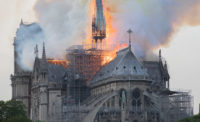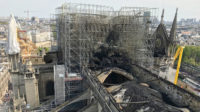Days after fire raced through the attic of the beloved Notre-Dame cathedral in Paris, experts cautioned that stabilization of the structure and rebuilding true to a heritage that stretches back to the 12th century would not be quick nor easy.
The French government, which owns and maintains Notre-Dame, was well aware of the fire risk of the heavy-timber structure that supported the roof—so dense with beams and braces that it was referred to as “the forest.” The government had wired the building with detectors and had full-time fire inspectors on site. After the first alarm on the evening of April 15, a marshal failed to locate the fire, causing a critical delay. By the time firefighters reached the flames, it had become a conflagration.
Protection officials assumed that the surface of the heavy oak timbers would char, slowing the penetration of heat and fire until occupants escaped and firefighters extinguished the flames. (U.S. building codes also assume heavy timber will char.)
The New York Times reported that the sheer number of the timbers in the attic’s close quarters likely permitted the fire to spread much faster than anticipated. Tim Michiels, an engineer and preservation specialist who has worked on many European churches and teaches at Columbia University’s Historic Preservation program, finds the explanation plausible. “When you have this giant surface area, the fire can spread and spread,” he explained.
Experts are now asking why there were not additional fire protections, such as sprinklers or fire-rated partitions to compartmentalize the attic. Michiels is reluctant to second guess decisions that might have lowered the fire risk at high cost to the ancient construction. “You want to maintain the integrity of the space, which is prescribed by international historic preservation guidelines. Who are we in the 21st century to intervene with sprinklers and fire barriers if they would cause irreversible damage to the monument?”
Compartmentalization would likely have involved cutting into the historic timbers, Michiels told RECORD, and sealing many penetrations. Sprinklers, should they introduce water into the attic, could induce the growth of rot, fungus, and wood-eating beetles.
The Notre-Dame tragedy also drew attention to an alarming fact: most historic-building conflagrations strike during renovations. The fire appears to have started in or near roof work underway near the cathedral spire, which was elaborately scaffolded, although its cause had not been determined when this article posted.
In the days that followed, French politics have marred both grieving and planning. Prime Minister Édouard Philippe quickly announced deep tax deductions to those contributing to the reconstruction. By April 18, close to $1 billion had been pledged, much of it by the richest families. That enraged self-described Yellow Vest street protesters, who have tried to reverse government service cuts and tax advantages enjoyed by the wealthy.
Prime Minister Phillippe also announced an open design competition to replace the 1860 wood-framed spire by Eugène-Emmanuel Viollet-le-Duc and Jean-Baptiste Lassus that collapsed during the fire. That opened a can of worms. Viollet-le-Duc’s work on this and many other monuments is understood as a kind of creative interpretation, and—the thinking goes—need not itself be restored exactly. Writing in the Washington Post, Meredith Cohen, an expert in medieval art and architecture who teaches at UCLA, asked, “Should the 19th- century techniques that were employed to build it also be reproduced? Which of [the cathedral’s] nearly nine centuries should be privileged?” To avoid such unfruitful debates, she endorses “a contemporary style that both harmonizes with the extant monument and also clearly distinguishes itself as a product of our time.”
But Barry Bergdoll, the former chief curator of architecture at the Museum of Modern Art, denounced the competition. “The cathedral as inherited is the monument,” he said, citing Viollet-le-Duc’s painstaking study of the cathedral before altering it. As a result, few people knew that the spire was not original, he added. “We should not extrapolate from Viollet-le-Duc's approach that it is okay to replace the spire with something quite different from the organic whole of the cathedral.”
Experts agree that stabilization is urgent. Several of the six-partite ceiling vaults collapsed, and some of the stonework may have been damaged by the heat of flaming debris, followed by the drenching by fire hoses. “They have to understand the state of this stonework before deciding what else must be done,” said Michiels.
There is unlikely to be enough French old-growth oak to recreate the attic “forest,” but the flames consumed more than just wood from trees dating back to the ninth century. “There are special joints, techniques, and carpenter’s marks on the wood members,” said Michiels. “All of that is lost.” A new wood attic would require more robust fire protection, possibly like the mist system that Murphy Burnham and Buttrick Architects specified for the wood-framed attic of New York’s St. Patrick’s Cathedral in their 2015 renovation of the space. That system can extinguish fires using only 10 percent of a typical sprinkler system’s output.
Since Notre-Dame’s attic was accessible to almost no one, framing the attic in modern materials, such as steel, may meet heritage requirements and minimize fire-protection measures. Rheims, another of France’s great cathedrals, received a concrete roof replacement after World War I. “Your appreciation is not affected,” said Michiels.







Post a comment to this article
Report Abusive Comment